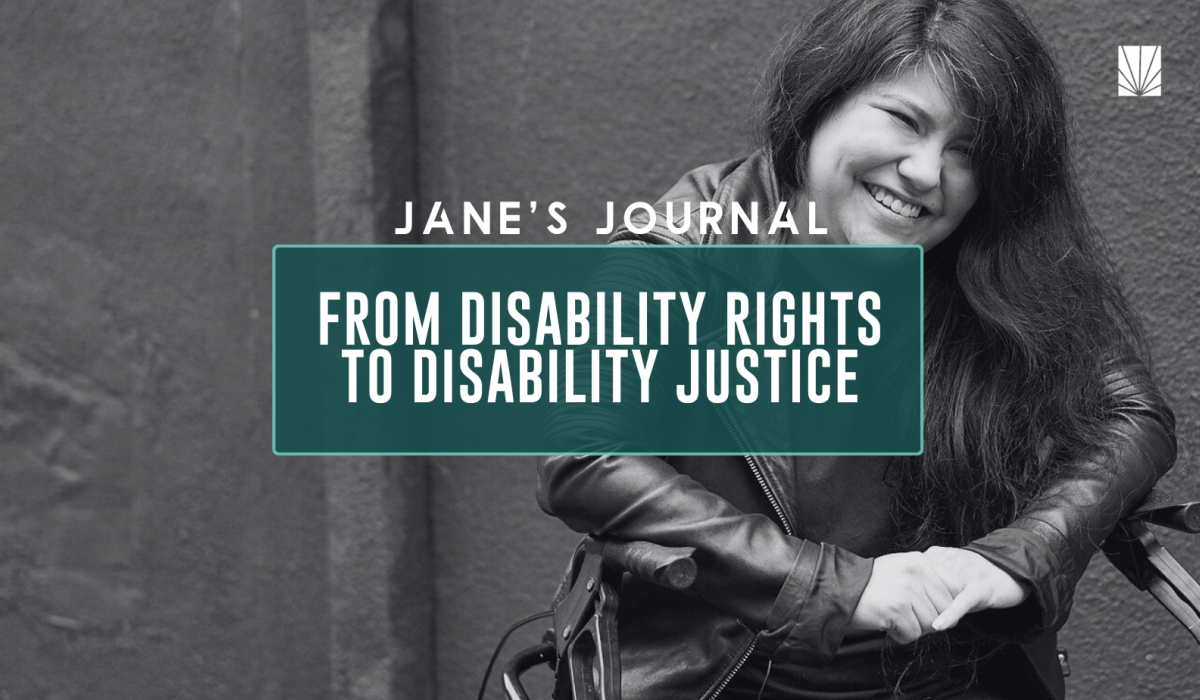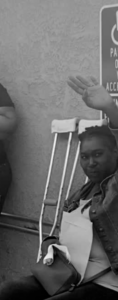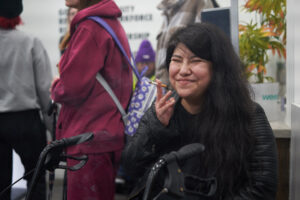
From Disability Rights to Disability Justice
In 1990, the disability rights movement achieved a landmark victory with the passage of the Americans with Disabilities Act (ADA) and the designation of July as Disability Pride Month. Like the Civil Rights movement of the 1960s and the gay rights movement of the 1980s and ‘90s, the disability rights movement sought basic legal protections for a minority identity.
Activists and allies asked for decades whether disabled people could enjoy the same opportunities and protections as their abled peers did regarding employment, housing, and access to public space. And, like similar civil rights legislation before it, the passage of the ADA felt like a resounding answer— Yes, they can.
Of course, a lot can change in thirty years, including the questions we ask.
Intersectionality and the Evolution of Social Justice
Just one year before the passage of the ADA, an academic scholar named Kimberlé Williams Crenshaw published her “Black Feminist Critique of Antidiscrimination Doctrine, Feminist Theory and Antiracist Politics.” In her critique, Crenshaw expanded on the work of fellow activists and critical race theorists like Sojourner Truth and W.E.B. Du Bois, who each explored the way layered identities of gender, race and class influenced experiences of oppression.
Crenshaw coined the term “intersectionality” to describe her dual experience of racism and sexism as a Black woman. Three decades later, intersectionality is a mainstream concept. We understand that it is impossible to separate, say, Blackness or femininity—or disability—in a society that sees all three identities as deviations from a norm limited to white, cis-hetero masculinity.
As fellow intersectional Black feminist Audre Lorde famously said, “We do not live single-issue lives.” With that awareness, many activists have moved beyond discourse and movements organized around a single marginalized identity toward a more inclusive goal of collective liberation.
To put it another way, the civil rights movements that transformed the twentieth century have, in the new millennium, evolved into a broader, more intersectional movement for social justice.
What Is Disability Justice?

Case in point—in 2005, a performance collective of queer, disabled women of color known as Sin Invalid made their own linguistic innovation when they crafted a ten-point definition of a new term: disability justice.
The first core principle on their list? Intersectionality.
The disability rights movement rejected the eugenicist view that disabled people are a drain on societal resources. Instead, activists asserted that disabled people could make meaningful contributions with the right accommodations and protections. The primary question was what those accommodations needed to be—and the ADA answered with several titles addressing employment, housing and accessibility discrimination.
Disability justice, on the other hand, asks a fundamentally different set of questions than its predecessor. Many of the core principles of disability justice outlined by Sin Invalid—its commitment to anti-capitalist politics, for example—ask not where disabled bodies fit into capitalism, but whether we should reject a capitalist system that values human ability primarily in terms of profitability.
As the fifth and tenth principles of disability justice state, “People have inherent worth outside of commodity relations and capitalist notions of productivity. Each person is full of history and life experience. No body or mind can be left behind.”
Cannabis Advocacy and Disability Justice
Of course, marginalized people getting left behind is exactly what tends to happen in a culture that views BIPOC, LGBTQIA+ and the disabled as exploitable resources and aberrations first and autonomous, fully realized and complex humans second—if at all.
Take, for example, the HIV/AIDS crisis of the 1980s and ‘90s. Queerness was incredibly stigmatized and even criminalized, especially for gay men. But gay man disabled by an incurable illness? That identity rendered a person untouchable, literally and figuratively, by the federal government, the medical establishment and mainstream public sentiment.
The gay rights movement of the 1990s was incredibly successful in humanizing queer people and reducing stigma. And many of the movement’s biggest wins were inherently intersectional. No one knew better than HIV/AIDS survivors how important it was to legally perform medical advocacy for one’s partner, or to be present at their end-of-life bedside. The fight for same-sex marriage was deeply intertwined with the advancement of disability rights.
Over the last thirty years, however, queer activists have been erased from some of their greatest achievements, like the widespread legalization of medical cannabis. Medical and adult-use cannabis markets have opened in the majority of U.S. states, but it isn’t HIV/AIDS patients or the underground cultivators and distributors who served them that have profited from that multi-billion dollar pot economy.
Nor have BIPOC, most impacted by the explicitly racist War on Drugs, gotten their fair share from legal cannabis either. Indeed, entire organizations like The Social Impact Center exist to extract people convicted of cannabis crimes out of the carceral state.
An increasing number of post-prohibition states have indeed enacted social equity programs to put justice-involved and minority entrepreneurs closer to the front of the line for highly coveted cannabis business licenses.
Still, the majority of cannabis entrepreneurs pulling revenue off legal sales are white, cis-gender men who never had skin in the legacy market. For all these reasons and more, cannabis advocacy is an excellent example of the intersectionality inherent to not only the disability justice movement but all social justice movements.
The Americans with Disabilities Act and Cannabis Legalization
Thirty years after the ADA was signed into law and California first legalized medical cannabis, marginalized communities find themselves more likely to be impacted by the friction between ADA protections and ongoing federal prohibition.
Because cannabis, medical or otherwise, is only legal under the laws of individual states, and because the ADA is federal legislation, cannabis use disqualifies many disabled medical consumers from ADA protections. As the Colorado Bar Association has noted,
“Active marijuana users, including patients with medical marijuana prescriptions, are deemed ‘current’ drug users under the ADA. Therefore, they are neither (1) qualified individuals with disabilities” under the ADA, nor (2) entitled to reasonable accommodations.
Such a stance goes back even further than Title II of the ADA with roots in Section 504 of the 1973 Rehabilitation Act. Women, BIPOC, LGBTQIA+ people and the incarcerated experience higher rates of disability than the general adult population. Medical racism, transphobia, fatphobia and misogyny create substantial barriers to physical and mental healthcare.
Intergenerational and present-day trauma present wide-ranging effects that in some cases can be quite disabling. Further weakening the health of marginalized communities are increased rates of food and housing insecurity, including that compounded by gaps in ADA protections and enforcement.
Under federal prohibition, for instance, residents of public housing still cannot consume cannabis. Even in states with legal medical markets, and even if consumption is smokeless or occurs off-premises, public housing residents cannot partake without risking eviction. Essentially, people with disabilities who use medical cannabis to treat conditions like chronic pain, epilepsy and PTSD are legally disqualified from public housing assistance.
According to the EEOC, the ADA does not protect medical cannabis users from mandatory drug testing by their employers, either. Nor does it safeguard against an employer’s refusal to hire a job candidate based on a positive cannabis test result as part of a pre-employment screening.
Despite widespread legality, medical cannabis consumption can disqualify organ transplant candidates, too. As of 2023, just 13 states have enacted laws that keep medical cannabis patients on organ transplant lists.
Cannabis legalization advocates cannot take a single-issue approach to resolving these issues. Rather, they must take their cues from disability justice advocates and the broader social justice movement.
When the DEA made its 2024 recommendation that cannabis be moved from Schedule I to Schedule III, much of the immediate response focused on the potential economic impact on cannabis businesses.
Fewer voices were asking what the implications might be for disabled or incarcerated Americans who currently consume, or would like to in the future. If cannabis rescheduling leads to a more medicalized cannabis market in which prescriptions replace medical marijuana cards, will that increase cannabis accessibility? Or does that paradigm present disabled people—many of whom are forced into poverty or divorce by income-capped benefit restrictions— yet another “crip tax?”
How Can Cannabis Contribute to Sustained Social Justice Efforts?

One of the core principles of disability justice is a “flexibility and creative nuance” the members of Sin Invalid attribute to their brown, black, queer and disabled identities. And as both clinical and anecdotal evidence suggests, flexibility of thinking and creative nuance can also be cultivated through cannabis consumption. Indeed, the very existence of the phrase “getting high about it” shows how often cannabis consumers use this plant as a means for furthering self-interrogation.
Beyond the immediate question of where cannabis consumers fit into disability protections, or where the disabled fit into the cannabis legalization movement, there are more imaginative possibilities and questions to ask.
To take an inquisitive cue from the notion that disabled bodies resist capitalist definitions of profitability and worth, does the value of cannabis lie in its ability to improve our experience and productivity?
If, as Sin Invalid put it, “our embodied experiences guide us toward ongoing justice and liberation” is cannabis a tool disabled people and their allies can leverage to sustain and amplify their social justice work? Can stigmatized effects like couch lock be reframed in terms of rest-as-resistance?
Better yet, if the long arc of disability justice bends toward collective access and collective liberation, should cannabis have ever been commodified (or even medicalized) in the first place? These are exactly the kind of questions we will be pondering one puff at a time throughout Disability Pride Month and beyond.
cannabis and disability, disability equity, disability justice, disability rights, reframing disability
